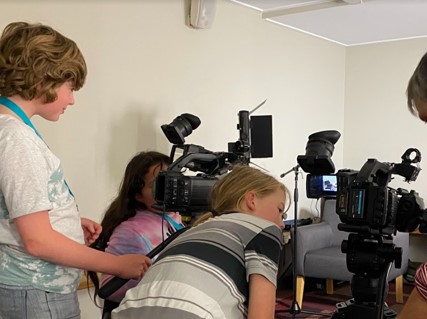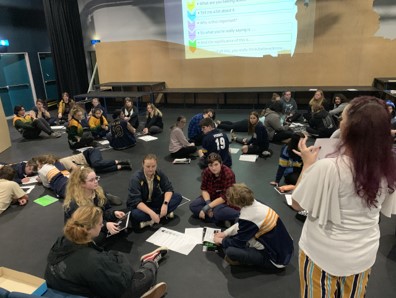Directing and acting
Ways directors can support actors
The director guides and directs creative decisions throughout the filmmaking process to develop and realise the creative intention of the film. Directors are responsible for bringing together all of the elements of the production – the look, sound, pace, mood, and performances. While directors ultimately have creative control of the production, the responsibility is shared and delegated among the cast and crew, who bring their own expertise, aesthetic, and creative choices to their roles.
Directors work closely with cast to develop strong performances that communicate the creative intention of the film through characterisation. Directors should establish positive, collaborative relationships with actors to get the most out of rehearsals. When directing actors, directors should use a range of techniques to enhance, strengthen or shape performances and give direction that is clear and easy to follow.
During rehearsals, the director needs to ensure time is used productively by having a clear, well-timed plan and a variety of strategies to support the rehearsal process. Types of rehearsal techniques the director may wish to use include:
- mental rehearsal – The cast focuses by rehearsing individually in their own mind
- talk through – A verbal review of the performance with a focus on using dialogue only. Previous notes from the director can be reiterated
- walk through – A physical review of the performance with a focus on using movement only
- map it out – Use a blocking map to talk the cast through movement and transitions in the space
- scene-by-scene – Practise key moments that require extra rehearsal or further improvements
- straight rehearsal – The cast moves through the whole performance, pausing for direction and workshopping when required
- technical rehearsal – A brief look at each scene with the cast in key moments. This will assist the design team in making final adjustments with set, colour and lighting
- dress rehearsal – A full run through of the performance with cast's props, costume, hair and makeup. This will assist the design team to identify any technical issues that negatively affect the cast's performance.


Activity – rehearsal techniques and strategies

As directors you can select a variety of rehearsal strategies from the table below. Use the selected strategies throughout the scene-by-scene and straight rehearsal to foster a positive and collaborative rehearsal environment.
- Read a scene once
-
Read the scene once, then improvise immediately. Identify what this strategy forces the actor to focus on. You are likely to highlight the objective of the scene and the action, rather than lines of dialogue. Reflect on your performance to ensure key moments as well as more subtle moments are being communicated.
- Improvisation with guidelines
-
A long improvisation exercise, without words and with guidelines such as using a prop, having a time limit, or meeting a physical goal. Ensure the guidelines you put in place are relevant to your performance.
- Discovery space
-
Individual scene work that focuses on play. Some strategies are outlined below.
- Allow actors to perform freely and own the scene.
- Define and clarify the actions of the cast through straight rehearsal of the performance.
- Engage in play by manipulating scenes through exploration by listening, responding, and investigating dialogue free moments.
- Accept offers by allowing the ensemble to step into a scene with physical offers as the actors play on.
- Language and rhythm
-
Individual scene work that focuses on the rhythm of the dialogue. Some strategies are outlined below.
- Find rhythm in the dialogue. Investigate the words that need stresses, inflections, or a particular tone. Consider the timing based on the comedy or emotion that is being portrayed through the dialogue.
- Explore musical rhythms and structures physically in space and then through the dialogue as teams and individuals.
- Study famous speeches and embody the rhythm and dialogue through active symbols.
- Build the ensemble’s understanding of rhythm, tempo and shared responsibility by treating the play like music, with defined beats for each part of the story.
- Puppetry
-
Individual scene work that focuses on highlighting key moments of dramatic action. Some strategies are outlined below.
- Play scenes on small scale, using small props and shadow play. Apply the key ideas discovered through the puppetry to the body.
- Create tableaux to represent different moments in the performance.
- Targeted training
-
Individual scene work that focuses on improving one targeted aspect. Some strategies are outlined below.
- Focus on physical theatre to improve fight scenes, movement and choreographed moments.
- Accent or voice work to meet the demands of the dialogue and character.
- Identify conflicts/tensions and where power is given or taken. Highlight key traits in characters and represent them as a symbol. Explore the scene to identify moments of boldness, tactics, success, failure, giving or taking of power and ensure symbols are being used in these moments to strengthen the dramatic action.
- Use stillness to perform the scene with dialogue only. Can eye contact and/or physical contact be maintained? When is it necessary to use stillness and when is it impossible?
- Transformation
-
Consider how the characters will transform throughout the play. Will they transform or remain unchanged? Is there a key moment or catalyst that causes the characters to change? Investigate how the characteristics are built around the key ideas in the play and can be used to highlight a transformation or lack of transformation. Experiment with movement, tone, expression and Laban’s effort actions.
- Image garden
-
Explore how the ensemble can be used during long speeches. The ensemble could create images to support the dialogue. The speaking actor is resisted or encouraged to physically engage with each image by the ensemble. Reflect on which option best supported the communication of the dramatic meaning.
- Collective research
-
Complete collective and personal research to contextualise the world of play (time, place, setting) and its characters.

